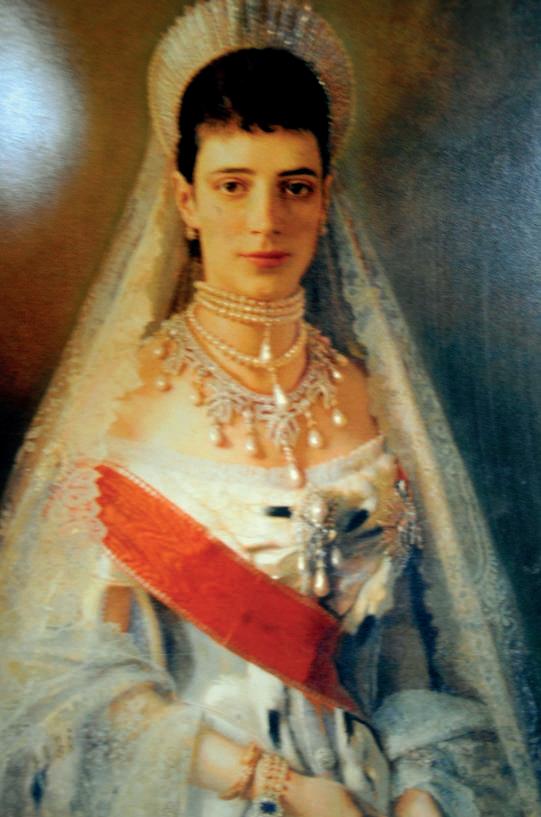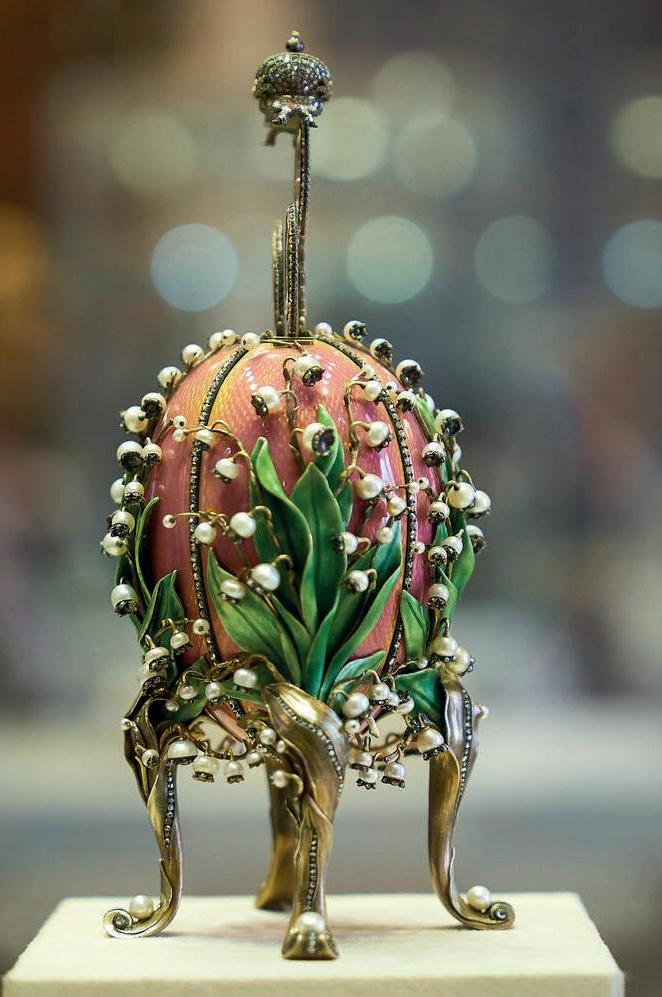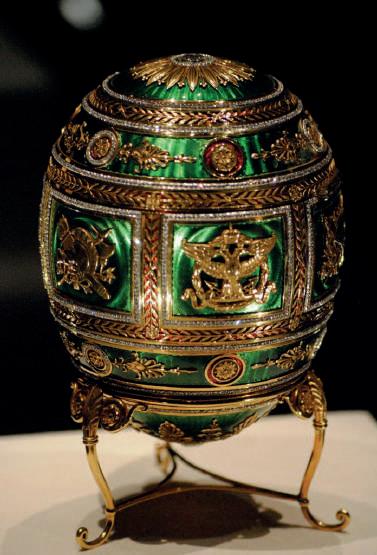
7 minute read
History

Maria Feodorovna, wife of Alexander III and mother of Nicholas II, received 30 Imperial eggs in all, which the Soviet Government "repossessed". She escaped the massacre of the Russian Imperial Family in 1917, and died in exile in her native Denmark in 1928; In 2005, her remains we re-interred, according to her wish, next to those of her husband in St Petersberg. Image by Dennis Jarvis.
Advertisement

The Cockerel Egg, presented by Nicholas II to Maria Feodorovna in 1900. The tiny cockerel on top is an automaton. The Renaissance Egg, made in jewelled agate and presented to Maria Feodorovna in 1894. It was the last egg that Alexander III gave to his wife before his death.


The Lilies of the Valley Egg, given to his wife Alexandra by Nicholas II in 1898. Now in the collection of Viktor Vekselberg.
Easter Eggs to Die for
IT IS VERY HARD TO CONCEIVE OF THE GAP BETWEEN THE REALITY OF POLITICS IN RUSSIA TOWARDS THE END OF THE 19TH CENTURY AND THE LIFE LIVED BY ITS RULING FAMILY
By Mike George
Mike George is our regular contributor on wildlife and the countryside in France. He is a geologist and naturalist, living in the Jurassic area of the Charente
Seen in isolation, the Romanovs were an adoring family, and their mutual love and generosity is touching to behold. However, they had no idea how far their lifestyle and extravagance were out of touch with the reality of life in the rest of Russia. The exchanging of extravagant presents was nothing out of the ordinary between family members, and the Easter season was especially important. Tsar Alexander III used to give his wife Maria Feodorovna jewelled Easter Eggs every year. However, the Nihilist enemies of the Imperial family got in on this idea, and in 1883 the Tsar and Tsarina received jewelled eggs containing miniature skulls with silver daggers, and the message that the Nihilists would eventually triumph. This left the Tsar with a problem of whom to trust. Then in 1885 his brother told him of a firm of loyal jewellers right on his doorstep who could be trusted to produce jewellery of surpassing beauty and ingenuity. In 1842, Gustav Fabergé, an ex-patriot German jeweller, had set up business in St. Petersburg. He had been joined by his son, Peter Carl Fabergé, a superb jewellery designer as well as a skilled businessman, and his reputation for making intricately and beautifully designed items was growing fast. The Tsar approached the firm and asked that Peter Carl should design for him an Easter Egg of surpassing beauty and intricacy. The result was the Hen Egg, a white enamelled egg about 2.5 inches across, which opened to reveal a gold yolk. The yolk contained a golden hen sitting on golden straw, and this in turn opened to disclose a miniature jewelled replica of the Imperial Crown and a ruby pendant. The Tsarina received the gift on 1st May 1885. The Tsarina was delighted with her egg, and the next year the Tsar appointed Peter Carl Fabergé “Goldsmith by special appointment to the Royal Crown” and ordered another egg, rather similar in concept to the previous year’s egg but this time containing a sapphire pendant. From this point on, an egg was ordered to be ready for each Easter, and Fabergé was given complete freedom to design each egg. Even the Tsar himself had no idea what the egg would look like, or even how big it would be. The only stipulation was that it must be unique, different from any other egg, and contain a surprise gift. Fabergé surrounded himself with a team of skilled jewellers to design and create the eggs. Each egg took on average a year to make. As word of them spread, he found himself dealing with orders from other wealthy collectors such as Alexander Kelch, a Russian goldmine industrialist, the Dutchess of Marlborough, the Rothschilds and the Yusupov family. Over the period 1885 to 1916, there were 50 Imperial eggs delivered to the Tsar for his Easter gifts, and 16 major eggs for other people. Tsar Alexander III continued his giftgiving right up to his death in 1894, when his son, Nicholas II, renewed the order for eggs to give to his wife, Alexandra Feodorovna, and also ordered a second egg for his mother, the dowager Empress Maria, who loved her jewelled egg each Easter. Of the 50 Imperial eggs that are known to have been made, Maria received 30 and Alexandra 20. The only years that eggs were not made were 1904 and 1905, when the Russo-Japanese War was in progress. In 1917, the Imperial Family was murdered by the insurgent Bolsheviks. Two eggs were in preparation. One was paid for but tragically never delivered, and no one was left to pay for the other. The House of Fabergé was nationalised by the Bolsheviks, and the Fabergé family fled to Switzerland, where Peter Karl died in 1920. Of the Imperial eggs, most disappeared after the death of the Imperial family. However; they began to surface again when foreign funds were required, and disappeared into private collections and occasionally museums. As of now, 6 have disappeared, although in a couple of cases the “surprise gift” that the missing egg had contained has been identified in other collections. Ten Imperial eggs are in the Kremlin collection, three are in the British Royal collection, and quite a number of them have been collected by Victor Vekselberg, a Russian oligarch who has stated it as his intention to preserve this important manifestation of Russian art and culture and display the eggs in Russia. He is known to have paid 100,000,000 dollars for a group of 9 of the Imperial eggs originally collected by the American publisher Malcolm Forbes. In 2013 he opened the Fabergé Museum in St Petersburg, to display the 9 Imperial eggs and other eggs and Fabergé items he had collected. Although they are made with consummate skill, and exhibit the finest examples of the jeweller’s art and craft, each egg’s intrinsic value is not thought to be very great. One was almost melted down for its gold content until it was recognised for what it was, when its value skyrocketed! The cachet, the history, and all the other attachments mean that famous Fabergé items sell for an unimaginable sum whenever one comes on the market. Although the eggs are usually described as “jewelled”, and of course they do bear and contain gemstones, the quality that strikes one most about the Fabergé eggs – and also the other high-quality items such as
Testus, CC BY-SA 4.0 <https://creativecommons.org/licenses/by-sa/4.0>, via Wikimedia Commons

The Bay Tree Egg was presented to Maria Feodorovna in 1911. The leaves are made of nephrite, a form of jade, and the egg contains a bird automaton. Twelve Monograms Egg, was in fact what had formerly been called the Alexandra III Portrait Egg, presented to Maria Feodorovna by Nicholas II in 1896. Now in America.


The Basket of Flowers Egg of 1901, presented by Nicholas II to his wife. This was eventually acquired by Queen Mary of England, and is in the British Royal collection. The Catherine the Great Egg or Grisaille Egg. It was presented to Maria Feodorovna by her son in 1914. The Napoleonic Egg, presented to Maria Feodorovna in 1912 to commemorate the centenery of the Battle of Borodino. Now on display at the Metropolitan Museum of Art, NY.


portrait boxes given as prestigious gifts to honoured visitors – is the quality of the enamelling. Fabergé and his craftsmen perfected the fiendishly difficult technique of enamelling “in the round”, and their skill in blending coloured enamels and laying down multiple layers of enamel flawlessly, was one of the firm’s chief claims to excellence, and is one of the checks that must be made during the authentication of a Fabergé piece. Although the whereabouts of most of the eggs is well-known, the few unaccounted for do allow the imaginations of novelists and film-makers to incorporate Fabergé eggs into their “blockbusters”. Even James Bond got involved (Octopussy 1983). Jessica Fletcher and even the Simpsons have encountered an egg! Few of us can contemplate owning a Fabergé item, let alone an Imperial egg. The firm is still in existence (although it has changed ownership several times since it was “nationalised”) and still holds its cachet, but its most valuable products have been imitated, and great care is needed to ensure a Fabergé item is genuine. I would just settle for a chocolate egg this Easter, if I were you.









